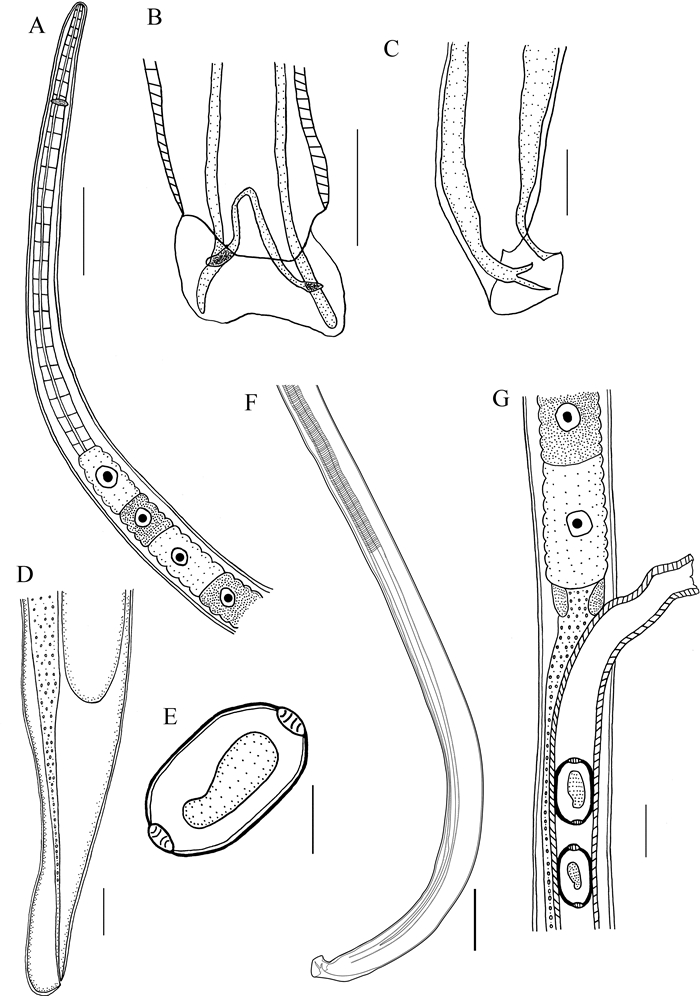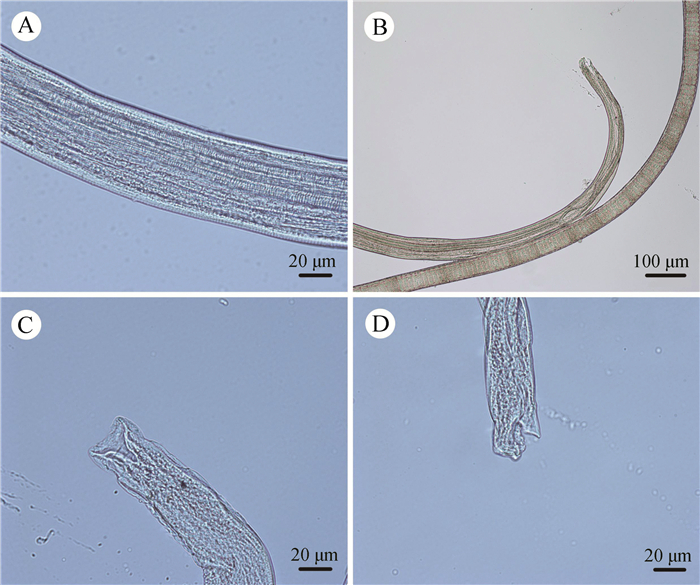扩展功能
文章信息
- 剧慧栋, 徐真, 马宁, 郭宁, 菅蕊, 赵明明, 林双龙, 翟士勇
- JU Huidong, XU Zhen, MA Ning, GUO Ning, JIAN Rui, ZHAO Mingming, LIN Shuanglong, ZHAI Shiyong
- 毛细属线虫中国新记录种的记述(嘴刺目:鞭虫科)
- Description of a New Record Species of Capillaria in China (Enoplida: Trichuridae)
- 四川动物, 2022, 41(1): 74-78
- Sichuan Journal of Zoology, 2022, 41(1): 74-78
- 10.11984/j.issn.1000-7083.20210212
-
文章历史
- 收稿日期: 2021-06-19
- 接受日期: 2021-11-11
2. 河北工程大学,河北邯郸 056038;
3. 石家庄市桥西区育英小学,石家庄050000;
4. 河北师范大学,石家庄 050000;
5. 承德医学院,河北承德 06700;
6. 石家庄市疾病预防控制中心,石家庄 050000
2. Hebei University of Engineering, Handan, Hebei Province 056038, China;
3. Yuying Primary School, Shijiazhuang 050000, China;
4. Hebei Normal University, Shijiazhuang 050000, China;
5. Chengde Medical College, Chengde, Hebei Province 067000, China;
6. Shijiazhuang Center for Disease Control and Prevention, Shijiazhuang 050000, China
寄生于翼手目Chiroptera的毛细属Capillaria线虫在全球均有分布:非洲7种(Justine, 1989a, 1989b)、欧洲5种(Niu et al., 2008)、大洋洲1种、美洲7种(Webster,1971;Raina & Kaul,1982)、亚洲4种(Meszaros,1973; 汪溥钦,1982); 我国仅报道1种C. pipistrelli Yamaguti,1941。本研究对广东省蝙蝠寄生线虫进行调查研究,发现毛细属一新记录种,该种在国内为首次报道。
1 材料与方法 1.1 线虫标本的采集、分离和保存标本于2018年9月采自广东省惠州市小蹄蝠Hipposideros pomona、大黄蝠Scotophilus heathi,龙门县长翅蝠Miniopterus schreibersi和广州市扁颅蝠Tylonycteris pachypus的小肠中。参照Ju等(2017)的方法,解剖蝙蝠采集的线虫分别放入不同的培养皿中,80 ℃热水将虫体烫直。线虫保存于70%乙醇中,在其中放置硫酸纸标签,标签详细记录宿主的种名、寄生部位、采集时间和地点等。
1.2 线虫的观察、绘图和鉴定将已固定的标本用75%乙醇或透明液制成临时装片,利用尼康光学显微镜(Eclipse Ni)对线虫标本的各部分进行初步观察,并使用显微测微尺测量标本的重要形态学特征,借助尼康可拍摄光学显微镜(Eclipse Ni)对线虫标本的主要形态特征进行鉴别并拍照。本文测量单位均为μm(文中另行标出的除外)。
2 越南毛细线虫Capillaria vietnamensis Meszaros, 1973鉴定特征:虫体细长,体前部呈丝状,食道由肌质部和杆状细胞组成,杆状细胞单排排列,在食道与肠交接处有2个环状细胞,后部稍粗。雄虫交合刺细长,交合刺鞘近端部分具横纹和纵纹,远端部分光滑,两部分长度比约为2∶ 1,交合刺鞘未伸出体外。交合伞呈围裙状,侧面各有1个突起支持,突起末端分为2支。尾部有窄的侧翼。雌虫阴门具较长的舌状瓣,虫卵的两端有透明塞状结构。
雄虫(5条):体长9.6~12.1(10.2) mm,神经环距头端的距离41~62(50),最大体宽71~81(77),体前端宽30~32(31),体后部宽51~57(54);食道长5.1~5.5(5.2) mm,细胞数30~32(31),肌质部长330~380(356);交合刺长1 123~1 233(1 162)。
雌虫(25条):体长10.6~11.8(11.0) mm,神经环距头端的距离56~70(63),最大体宽118~ 130(124),体前端宽15~19(17),体后部宽76~90(81);食道长5~5.4(5.2) mm,细胞数30~32(31),肌质部长320~390(361);阴门距食道167~226(192),舌状瓣长50~100(82),肛门距尾端15~30(22),虫卵大小48~76(58)×24~37(30)。
3 讨论毛细属线虫种类众多,4个亚属分别是Procapillaria、Neocapillaria、Capillaroides和Hepatocapillaria,而寄生于蝙蝠的毛细线虫报道了29种,我国仅报道1种C. pipistrelli Yamaguti,1941(汪溥钦,1982)。所采标本的形态特征与Meszaros(1973)报道的寄生于Scotophilus temmincki的越南毛细线虫的描述一致,但原始描述相对简单,本研究增加了体前端、体后部的宽度,神经环距头部的距离的描述,食道细胞的个数,食道肌质部的长度,雌虫肛门距尾端的距离,增加了交合刺及交合刺鞘的手绘图和光镜图。Meszaros (1973)依据采自小黄蝠Scotophilus temmincki体内的寄生线虫命名了该种。本研究从大黄蝠、小蹄蝠、长翅蝠和扁颅蝠中发现了该种线虫,扩展了该线虫的宿主范围。原始描述中,雄虫交合刺长1.30 ~1.35 mm,本研究中,雄虫交合刺长1.123~ 1.233 mm (1.162 mm),略短于原始报道,可能与两者来源于不同的宿主有关,也可能与不同的生存环境有关。从主要形态上来看,越南毛细线虫的雄虫尾部、交合刺鞘近端具横纹和纵纹,远端光滑的特征,雌虫阴门舌状瓣的大小和形态,雌虫尾部特征与本实验所采标本的特征一致。因此确定该种线虫为越南毛细线虫, 在我国为首次报道,为我国新记录种。
| 序号 | 宿主 | 采集时间 | 采集地 | 检视标本 | 寄生部位 | 感染率/% (感染数/解剖数) |
感染强度/条 |
| 1 | 小蹄蝠 Hipposideros pomona |
2018年9月 | 广东省惠州市罗浮山 (114.4°E,23.1°N) |
2雄20雌 (HBNU-M1018) |
小肠 | 14(1/7) | 22 |
| 2 | 大黄蝠 Scotophilus heathi |
2018年9月 | 广东省惠州市罗浮山 (114.4°E,23.1°N) |
18雌 (HBNU-M1019) |
小肠 | 50(1/2) | 18 |
| 3 | 长翅蝠 Miniopterus schreibersi |
2018年9月 | 广东省龙门县 (114.3°E,23.7°N) |
1雄16雌 (HBNU-M1020) |
小肠 | 33(2/6) | 5~8 |
| 4 | 扁颅蝠 Tylonycteris pachypus |
2018年9月 | 广东省广州市越秀公园 (113.3°E,23.2°N) |
12雌 (HBNU-M1021) |
小肠 | 50(1/2) | 12 |

|
| 图 1 越南毛细线虫Capillaria vietnamensis Meszaros, 1973, 采自小蹄蝠Hipposideros pomona Fig. 1 Capillaria vietnamensis Meszaros, 1973 from Hipposideros pomona A.雄虫前部, 侧面观; B. 雄虫尾部, 腹面观; C. 雄虫尾部, 腹侧面观; D. 雌虫尾部, 侧面观; E. 虫卵; F. 雄虫尾部, 侧面观, 示交合刺和交合刺鞘; G. 雌虫阴门, 侧面观; 比例尺:A、D、F、G=40 μm, B、C、E=20 μm A. anterior end of male, lateral view; B. posterior end of male, ventral view; C. posterior end of male, latero-ventral view; D. posterior end of female, lateral view; E. egg; F. posterior end of male, lateral view, showing the spicule and sheath of spicule; G. vulval region, lateral view; scale bars: A, D, F, G=40 μm, B, C, E=20 μm |
| |

|
| 图 2 越南毛细线虫Capillaria vietnamensis Meszaros, 1973雄虫, 光镜图片, 采自小蹄蝠Hipposideros pomona Fig. 2 Light microscope of male Capillaria vietnamensis Meszaros, 1973 from Hipposideros pomona A. 雄虫头端, 侧面观; B. 食道杆细胞, 侧面观; C. 食道杆细胞放大, 侧面观; D. 食道与肠交接, 侧面观 A. anterior part of male, lateral view; B. stichosome, lateral view; C. magnified stichosome, lateral view; D. esophago-intestinal junction, lateral view |
| |

|
| 图 3 越南毛细线虫Capillaria vietnamensis Meszaros, 1973雄虫, 光镜图片, 采自小蹄蝠Hipposideros pomona Fig. 3 Light microscope of male Capillaria vietnamensis Meszaros, 1973 from Hipposideros pomona A. 雄虫交合刺鞘放大, 侧面观; B. 雄虫尾端, 侧面观; C. 雄虫尾端放大, 腹面观; D. 雄虫尾端放大, 侧面观 A. magnified specular sheath, lateral view, showing the transverse and longitudinal grooves; B. posterior end of male, lateral view; C. magnified posterior end of male, ventral view; D. magnified posterior end of male, lateral view |
| |

|
| 图 4 越南毛细线虫Capillaria vietnamensis Meszaros, 1973雌虫, 光镜图片, 采自小蹄蝠Hipposideros pomona Fig. 4 Light microscope of female Capillaria vietnamensis Meszaros, 1973 from Hipposideros pomona A. 雌虫尾端, 侧面观; B. 雌虫阴门, 侧面观; C. 虫卵, 侧面观; D. 雌虫头端, 侧面观 A. posterior end of female, lateral view; B. vulval region, lateral view; C. egg, lateral view; D. anterior part of female, lateral view |
| |
汪溥钦. 1982. 福建毛细科(鞭尾目)线虫记述[J]. 动物分类学报, 2: 6-15. |
Ju HD, Li L, Zhang LP. 2017. Durettenema guangdongense gen. et sp. nov. (Nematoda: Molineoidea) from Hipposideros larvatus (Horsfield) (Chiroptera: Rhinolophidae) with discussion of the taxonomic status of Macielia rhinolophi Yin, 1980[J]. Acta Parasitologica, 62(3): 575-581. |
Justine JL. 1989a. Quatrenouvelles espèces de Capillaria (Nematoda, Capillariinae) parasites de Chiroptères du Gabon[J]. Bulletin De Museum National Dhistoire Naturelle, 11(a): 535-561. |
Justine JL. 1989b. Une nouvelleespèce de Capillaria (Nematoda, Capillariinae) parasite de Chauve-souris (Mammalia, Chiroptera) du Gabon[J]. Bulletin De Museum National Dhistoire Naturelle, 11(a): 333-347. |
Meszaros F. 1973. Parasitic nematodes of bats in Vietnam.Ⅰ[J]. Parasitologia Hungarica, 6: 149-167. |
Niu K, Kirillov AA, Vekhnik VP. 2008. Nematodes (Nematoda) from bats (Chiroptera) of the Samarskaya Luka Peninsula (Russia)[J]. Parazitologiia, 42(6): 526-532. |
Raina MK, Kaul RK. 1982. On a new species of Capillaria (Nematoda) from a bat in Kashmir[J]. Angewandte Parasitologie, 23(1): 28-31. |
Webster WA. 1971. Studies on the parasites of Chiroptera.Ⅰ. Helminths of Jamaican bats of the genera Tadarida, Chilonycteris, and Monophyllus[J]. Proceedings of the Helminthological Society of Washington, 38(2): 195-199. |
 2022, Vol. 41
2022, Vol. 41




